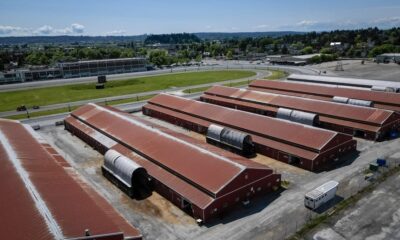Science
Manitoba’s Churchill Marine Observatory Marks One Year of Research

A significant milestone has been reached by the Churchill Marine Observatory (CMO) in Manitoba, as it celebrates its first year of operation. This multidisciplinary research facility, part of the University of Manitoba, focuses on advancing Arctic science and aims to address complex questions that carry socioeconomic implications.
The CMO officially opened on August 27, 2024, with an investment of approximately $45 million. Dr. Feiyue Wang, project lead and professor at the university’s Clayton H. Riddell Faculty of Environment, Earth, and Resources, emphasized the facility’s importance in putting Manitoba on the global map for marine research. The CMO’s design allows researchers to draw seawater from the Hudson Bay and the mouth of the Churchill River, facilitating a variety of experimental studies.
“This kind of arrangement allows us to do experimental studies, to study different scenarios as the Hudson Bay environment areas are going through rapid change,” Dr. Wang explained. The facility provides a critical platform for investigating the region’s evolving marine conditions and aims to prepare local communities for environmental changes.
The CMO is equipped to conduct research on risk reduction and mitigation strategies, particularly concerning oil spill responses in the region. In addition, the facility allows for studies into freshwater impacts on the marine ecosystem within Hudson Bay. Researchers employ a multitude of sensors attached to strings molded to the river and bay’s bottoms to monitor various physical and biological water properties.
The CMO also operates a research vessel, the William Kennedy, which enhances its capabilities for sampling and monitoring marine conditions. Though many projects are still ongoing, Dr. Wang noted that the observatory supported three significant research initiatives between November 2024 and February 2025. One such project investigated the initial stages of thin ice formation and involved collaboration with researchers from Denmark.
Another study, led by a colleague of Dr. Wang, examined the ability of natural microorganisms to degrade oil in ice-covered waters, a critical factor in understanding potential ecological responses to oil spills. The data gathered from this research is currently being analyzed, with plans for continuation in the coming winter months.
Looking towards the future, Dr. Wang expressed a desire to involve Indigenous researchers and community members more actively in the observatory’s projects. He highlighted the importance of local knowledge and investment in the research process.
“Folks who live there, who call that region home, are the ones who are going to be more invested in it,” he stated. While some community involvement has been incorporated, Dr. Wang hopes for a more prominent role for local participants in the CMO’s research agenda.
As the CMO celebrates its first anniversary, its contributions to Arctic marine science and community engagement underscore the facility’s potential for addressing pressing environmental challenges in the region.
-

 Science1 week ago
Science1 week agoMicrosoft Confirms U.S. Law Overrules Canadian Data Sovereignty
-

 Technology1 week ago
Technology1 week agoGoogle Pixel 10 Pro Fold Specs Unveiled Ahead of Launch
-

 Technology1 week ago
Technology1 week agoWorld of Warcraft Players Buzz Over 19-Quest Bee Challenge
-

 Science1 week ago
Science1 week agoXi Labs Innovates with New AI Operating System Set for 2025 Launch
-

 Science5 days ago
Science5 days agoChina’s Wukong Spacesuit Sets New Standard for AI in Space
-

 Science1 week ago
Science1 week agoInfrastructure Overhaul Drives AI Integration at JPMorgan Chase
-

 Health5 days ago
Health5 days agoRideau LRT Station Closed Following Fatal Cardiac Incident
-

 Technology1 week ago
Technology1 week agoHumanoid Robots Compete in Hilarious Debut Games in Beijing
-

 Top Stories1 week ago
Top Stories1 week agoSurrey Ends Horse Racing at Fraser Downs for Major Redevelopment
-

 Technology1 week ago
Technology1 week agoNew IDR01 Smart Ring Offers Advanced Sports Tracking for $169
-

 Science1 week ago
Science1 week agoNew Precision Approach to Treating Depression Tailors Care to Patients
-

 Technology1 week ago
Technology1 week agoFuture Entertainment Launches DDoD with Gameplay Trailer Showcase
-

 Technology1 week ago
Technology1 week agoGlobal Launch of Ragnarok M: Classic Set for September 3, 2025
-

 Technology1 week ago
Technology1 week agoInnovative 140W GaN Travel Adapter Combines Power and Convenience
-

 Lifestyle5 days ago
Lifestyle5 days agoVancouver’s Mini Mini Market Showcases Young Creatives
-

 Business1 week ago
Business1 week agoNew Estimates Reveal ChatGPT-5 Energy Use Could Soar
-

 Health1 week ago
Health1 week agoGiant Boba and Unique Treats Take Center Stage at Ottawa’s Newest Bubble Tea Shop
-

 Business1 week ago
Business1 week agoSimons Plans Toronto Expansion as Retail Sector Shows Resilience
-

 Business1 week ago
Business1 week agoUkraine Strikes Lukoil Refinery, Halting Operations Amid Conflict
-

 Lifestyle1 week ago
Lifestyle1 week agoEleven Madison Park to Reinstate Meat After Vegan Experiment
-

 Lifestyle4 days ago
Lifestyle4 days agoOntario Woman Wins $100,000 Lottery Prize from Brother’s Gift
-

 Technology1 week ago
Technology1 week agoDiscover the Relaxing Charm of Tiny Bookshop: A Cozy Gaming Escape
-

 Technology5 days ago
Technology5 days agoApple Shifts iPhone 18 Launch to Early 2027, Reports Indicate
-

 Technology1 week ago
Technology1 week agoBorderlands 4 Promises Massive Changes with 30 Billion Guns










